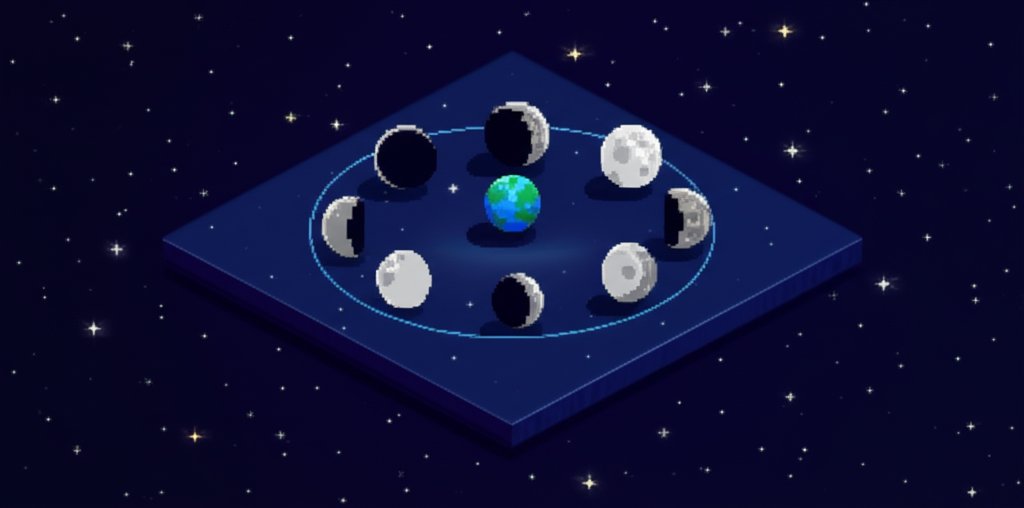The night sky, a canvas of endless wonder, holds countless celestial phenomena that have captivated humanity for millennia. Among these, the Moon, our closest cosmic companion, constantly transforms its appearance, cycling through distinct moon phases. While the New Moon’s invisibility and the Full Moon’s dazzling brilliance are well-known, it’s the subtle, growing luminosity of an often-overlooked phase that truly embodies progress and potential: the waxing gibbous.
Understanding the waxing gibbous isn’t just about recognizing a shape in the sky; it’s about unlocking a deeper appreciation for the intricate lunar cycle and the scientific marvels at play. This comprehensive guide will delve into the essential waxing gibbous facts, revealing its scientific underpinnings, cultural significance, and practical tips for observing this enchanting celestial spectacle. Prepare to illuminate your knowledge of our Moon’s most dynamic phase!
While the waxing gibbous focuses on scientific observation, it’s interesting to note that not all lunar studies delve into astrology, as explored in this NYT article about astronomy. astronomy in this.
Understanding the Waxing Gibbous Moon: A Celestial Introduction
The waxing gibbous phase marks a crucial period in the Moon’s monthly journey around Earth, a time when its illuminated face visibly expands each night, drawing ever closer to the brilliance of the Full Moon.
Defining the Waxing Gibbous: Form and Name
At its core, a waxing gibbous moon is characterized by more than half of its surface being illuminated, but not yet fully. The term “gibbous” originates from the Latin word gibbosus, meaning “humpbacked” or “convex,” aptly describing its swollen, asymmetrical shape. “Waxing” signifies growth or increasing illumination, differentiating it from the “waning” phases where the light recedes. This phase is distinct: it’s no longer a slender crescent and not yet a perfect circle, but a luminous, bulging form.
The Science of Illumination: How Sunlight Creates Phases
The moon phases we observe are not due to the Moon casting its own light, but rather to the ever-changing angles at which we view the Moon’s sunlit surface as it orbits Earth. The Moon itself is always half-lit by the Sun – much like Earth has a day and night side. As the Moon completes its roughly 29.5-day lunar cycle, the portion of its sunlit side visible from Earth shifts. The imaginary line separating the illuminated side from the dark side is called the terminator. During the waxing gibbous phase, the terminator gradually creeps across the lunar disc from west to east, revealing more and more of the Moon’s face to our gaze.
The Waxing Gibbous in the Grand Lunar Cycle
To truly grasp the significance of the waxing gibbous, it’s essential to understand its specific position within the broader lunar cycle – a ceaseless celestial dance that orchestrates all moon phases.
Tracing the Lunar Journey: From New Moon to Full
The lunar cycle is typically divided into eight distinct moon phases, each marking a natural progression in the Moon’s orbit:
- New Moon: The Moon is between the Earth and the Sun, making it invisible from Earth.
- Waxing Crescent: A sliver of light appears on the right side (Northern Hemisphere).
- First Quarter: Half of the Moon’s face is illuminated, appearing like a perfect “D” shape.
- Waxing Gibbous: More than half is illuminated, growing towards the full phase.
- Full Moon: The entire face of the Moon is illuminated.
- Waning Gibbous: More than half is illuminated, but the light is now decreasing.
- Third Quarter (or Last Quarter): Half of the Moon’s face is illuminated, appearing like a backward “D”.
- Waning Crescent: A sliver of light remains on the left side, shrinking towards new moon.
The waxing gibbous phase directly follows the First Quarter Moon and immediately precedes the Full Moon. It is a period of intense visual growth, preparing the night sky for its most radiant display.
Precise Timing and Duration of the Waxing Gibbous Phase
The waxing gibbous phase typically lasts for approximately 6 to 7 days. It begins when the Moon is just over 50% illuminated and continues until it reaches nearly 100% illumination, just before the Full Moon.
For observers in the Northern Hemisphere, during the waxing gibbous phase:
This extended visibility makes it an excellent time for casual observers and serious stargazers alike to marvel at its increasing brilliance and detailed surface features.
The Synodic Month: A Full Lunar Cycle Explained
A full lunar cycle, also known as a synodic month, averages 29 days, 12 hours, 44 minutes, and 2 seconds. This period is measured from one New Moon to the next, representing the time it takes for the Moon to complete one full orbit around Earth relative to the Sun. Each of the moon phases is a snapshot within this continuous astronomical event. The consistent duration of the synodic month ensures that the waxing gibbous phase, along with all other phases, occurs with predictable regularity, making the study of these celestial phenomena both accessible and rewarding.
Beyond the Light: Fascinating Facts About Waxing Gibbous
The waxing gibbous is more than just a transition phase; it’s a dynamic period offering unique observational opportunities and insights into our Moon. Let’s explore some captivating facts about waxing gibbous.
A Beacon of Progress and Building Energy
Symbolically, the waxing gibbous is often associated with progress, refinement, and the gathering of energy. As the Moon swells with light, it reflects a period of heightened activity and the successful implementation of intentions set during the New Moon. It’s a time for reviewing and adjusting plans, pushing forward with determination, and feeling the momentum build towards a major culmination. This analogy extends beyond the celestial, inspiring personal growth and the pursuit of goals.
Observing the Moon’s Topography in Detail
One of the most remarkable facts about waxing gibbous is its ideal condition for detailed astronomical observation. Unlike the blinding glare of the Full Moon, the waxing gibbous offers a perfect balance of illumination and shadow. The terminator, the line separating the light and dark sides, provides dramatic contrasts. Along this line, craters, mountains, and valleys are cast in sharp relief, with long shadows emphasizing their three-dimensional depth. This allows for unparalleled views of the lunar landscape, revealing intricacies that would be washed out under full illumination. Enthusiasts with binoculars or telescopes can spend hours exploring the Moon’s rugged beauty during this phase.
The “Humpbacked” Appearance: A Unique Visual Signature
The distinctive gibbous shape, Latin for “humpbacked,” is a key identifier. It’s not perfectly round like the Full Moon, but rather has a noticeably bulging profile. This asymmetry is what makes it visually fascinating and a clear indicator of its position in the lunar cycle. Recognizing this specific shape helps distinguish it from other moon phases, especially the waning gibbous, which appears similarly shaped but illuminated on the opposite side.
Why it’s a Prime Target for Stargazers
For both amateur astronomers and casual sky-watchers, the waxing gibbous presents an optimal viewing window. Its increasing brightness makes it easy to spot even in light-polluted areas, and its prolonged presence in the night sky provides ample opportunity for observation. The subtle changes in illumination from one night to the next offer a dynamic viewing experience, allowing observers to literally watch the Moon “grow.” This accessibility and visual richness solidify its status as a favorite celestial phenomena for many.
Cultural Resonance and Astrological Significance

Beyond its scientific definition, the waxing gibbous Moon has woven itself into human culture, influencing beliefs, folklore, and spiritual practices across civilizations.
Ancient Beliefs and Modern Interpretations
Throughout history, the waxing gibbous has held various meanings. Many ancient agricultural societies saw this phase as a time of preparation for harvest, a period of watchful growth and nurturing before the abundance of the Full Moon. It represented the tangible results of earlier efforts, symbolizing fruitfulness, development, and the nearing completion of endeavors. In some traditions, it was a time for reflection on progress made and for strengthening intentions, much like the Moon gains strength from the sun’s light.
Astrological Connections: Zodiac and Energy Amplification
In astrology, the waxing gibbous phase is often associated with refinement and assessment. It’s a period for taking stock of what’s been initiated, fine-tuning plans, and ensuring that everything is on track for the Full Moon’s culmination. It’s considered a time when energy is building, fostering growth and expanding possibilities. While the original article linked it to specific zodiac signs like Cancer, Leo, and Virgo, a more general astrological interpretation highlights its role in consolidating power and preparing for manifestation, regardless of the zodiac alignment. It encourages action, but with careful consideration and integration of lessons learned during earlier moon phases.
The Waxing Gibbous as a Symbol of Fulfillment
Ultimately, the waxing gibbous serves as a powerful natural symbol of approaching fulfillment. It represents the journey towards completion, the final push before the peak. Just as the Moon’s light grows irresistibly towards its fullest potential, this phase encourages us to put in the final efforts, to trust the process, and to anticipate the rewards of our endeavors. It’s a cosmic reminder that significant achievements are often preceded by periods of intense, steady growth.
Observing the Waxing Gibbous Moon: Tips for Stargazers
Witnessing the waxing gibbous is a simple yet profoundly rewarding experience. Here’s how to make the most of this captivating celestial phenomena.
Best Times for Viewing
The waxing gibbous Moon is typically visible from late afternoon, shortly after sunset, throughout much of the night. As it progresses towards the Full Moon, it rises earlier and stays visible longer. You can easily spot it high in the sky during the evening hours, casting distinct shadows and illuminating the landscape below. Check a local moon calendar or astronomy app for precise moonrise and moonset times in your location to plan your observations.
What to Look For (Naked Eye, Binoculars, Telescope)
- Naked Eye: Observe its distinct “humpbacked” shape and steadily increasing brightness. Note how it dominates the night sky, especially as it approaches the Full Moon.
- Binoculars: Even a modest pair of binoculars (e.g., 7×50 or 10×50) will reveal dozens of craters, the vast, dark plains known as maria (seas), and major mountain ranges. Focus on the region near the terminator for the most dramatic shadows and textural details.
- Telescope: A telescope will unlock an incredible amount of detail. The terminator is your best friend here; scan along it to see crater walls, central peaks, and rilles (narrow channels) in stunning three-dimensional clarity. The changing angle of sunlight each night offers a new perspective on these features.
Capturing the Celestial Phenomenon: Photography Tips
Photographing the waxing gibbous can be a rewarding challenge:
- Equipment: A camera with manual controls (DSLR or mirrorless), a telephoto lens (200mm or more is ideal), and a sturdy tripod.
- Settings: Use a relatively fast shutter speed (e.g., 1/125 to 1/500 sec, depending on brightness), a low ISO (100-400) to minimize noise, and a closed-down aperture (f/8 to f/11) for sharpness.
- Focus: Manual focus is crucial. Use live view to zoom in and achieve pinpoint sharpness.
- Timing: Shoot when the Moon is higher in the sky to minimize atmospheric distortion. Experiment with exposure, as the Moon is brighter than you might expect.
By following these tips, you can capture the stunning beauty and intricate details of the waxing gibbous, commemorating your personal connection with this incredible celestial phenomena.
Conclusion
The waxing gibbous Moon, with its distinctive “humpbacked” silhouette and steadily growing luminescence, is far more than just an intermediate moon phase. It’s a dynamic and captivating celestial phenomena that embodies growth, intensity, and the journey towards fulfillment within the continuous lunar cycle. From its precise scientific definition to its rich cultural symbolism and optimal viewing conditions, understanding the waxing gibbous facts enriches our connection to the cosmos.
As you gaze at the night sky, take a moment to appreciate this radiant, progressing phase. It serves as a powerful reminder of the cyclical nature of existence, the relentless pursuit of potential, and the breathtaking beauty that unfolds when light and shadow dance across our celestial neighbor. The next time the waxing gibbous graces our skies, remember the secrets it holds and allow its growing light to inspire your own journey of growth and discovery.
FAQ

What is the precise definition of a waxing gibbous moon?
A waxing gibbous moon is a moon phase where more than half (typically between 50.1% and 99.9%) of the Moon’s face is illuminated by the Sun, and that illuminated portion is visibly increasing each night as it moves towards the Full Moon. The term “gibbous” refers to its convex or “humpbacked” shape.
How long does the waxing gibbous phase last?
The waxing gibbous phase typically lasts for approximately 6 to 7 days. It begins immediately after the First Quarter Moon and concludes when the Moon reaches its Full Moon phase.
Can you see the waxing gibbous moon during the day?
Yes, the waxing gibbous moon can often be seen during the day. It rises in the late afternoon or early evening and remains visible in the sky through much of the night and often into the morning hours, sometimes even after sunrise, depending on its exact position in the lunar cycle.
How does the waxing gibbous differ from the waning gibbous?
Both waxing gibbous and waning gibbous moons appear more than half illuminated. The key difference lies in their progression and which side is illuminated. A waxing gibbous moon’s illumination is increasing (growing towards Full Moon), with the right side (Northern Hemisphere) being the most illuminated portion. A waning gibbous moon’s illumination is decreasing (shrinking towards Third Quarter), with the left side (Northern Hemisphere) being the primary illuminated portion.
What is the significance of the waxing gibbous in terms of energy or symbolism?
Symbolically, the waxing gibbous is often associated with building momentum, refinement, and progress. It’s seen as a time for reviewing efforts, making adjustments, and focusing energy towards the culmination that the Full Moon represents. It signifies a period of intense growth and the nearing fulfillment of intentions.
Why is it called “gibbous”?
The term “gibbous” comes from the Latin word gibbosus, meaning “humpbacked” or “convex.” This aptly describes the Moon’s bulging, asymmetrical shape during this phase, where it appears fuller than a half-moon but not yet perfectly round.










